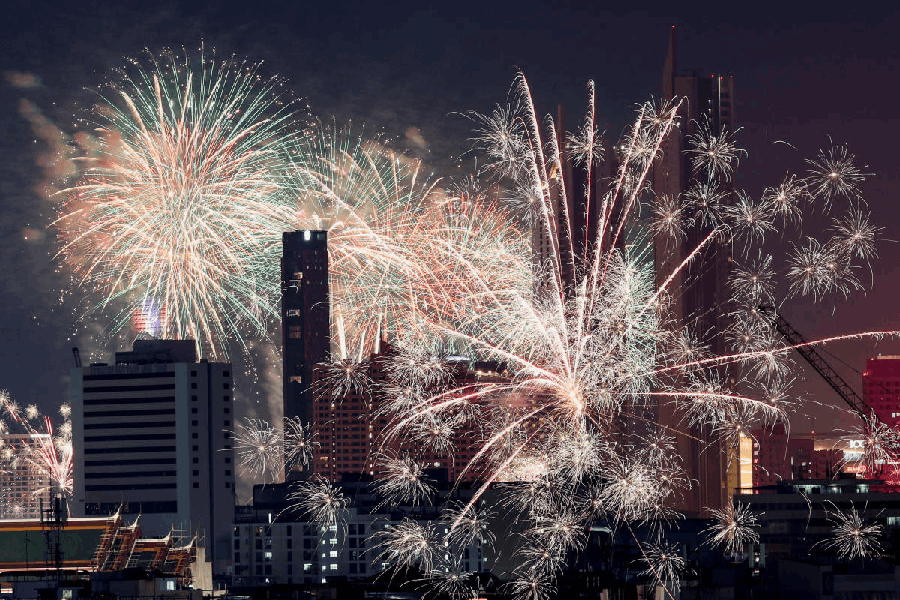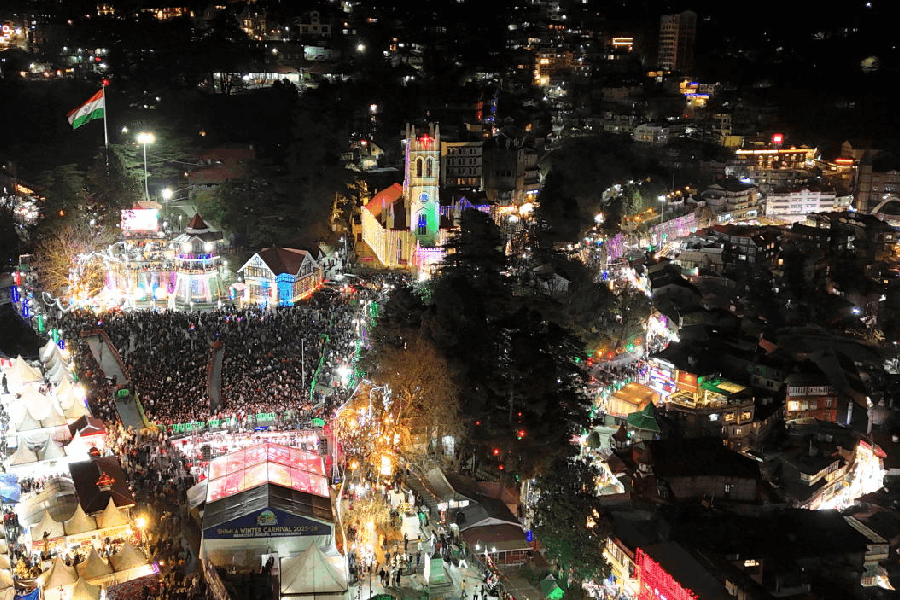 |
| Paracommandos on the trot during a rehearsal in Delhi. Picture by Ramakant Kushwaha |
For 10 days now, Maj. Sudeep Dutta of the 20th Rajputana Rifles stationed in Delhi Cantonment has been driving with his men in the bitter cold every night at 2.30am to Vijay Chowk at the base of the capital’s Raisina Hill.
Maj. Dutta’s unit is in charge of security at the crossing from where the Republic Day parade will start on the morning of January 26.
The soldiers of the battalion position themselves on the walls of South Block and North Block, inspect the greens in front of Parliament House and the galleries that are put up every year for the spectacle. Their responsibility also includes frisking the participants in the parade, many of them their own comrades-in-arms.
The grand parade in New Delhi is the highlight of Republic Day celebrations across the country. In recent years, particularly since the December 13, 2001, attack on Parliament, security has been stringent for the event. The army unit that moves to Vijay Chowk in the dead of the cold nights makes up only one layer of security.
Even if watching the watchmen is a rigorous and tedious business, the spectacle of the parade continues to enthral tens of thousands. They queue up early in the morning to get into one of the enclosures in the galleries, specially erected on either side of Rajpath every year. Preparations for the parade start as early as October.
The Republic Day parade is principally an event of the President who is the supreme commander of the armed forces. It showcases some of the most potent weapon systems and platforms. It showcases also the potential of the fourth-largest military in the world — in terms of personnel.
The contingents at the parade are drawn from selected battalions. Participants from the army, navy, air force, Coast Guard, the paramilitary and police forces, the National Cadet Corps, schools and states find themselves on Rajpath through a competitive process.
The parade starts at Raisina Hill and ends at the Red Fort but it is on Rajpath, from Vijay Chowk to India Gate, that the principal action takes place. The co-ordination involved is massive.
The critical element is the flypast, for which the air force may involve its men and aircraft from airfields from Pune to Ambala, with each element having to fly over Rajpath at the precise moment assigned to them.
This means that weather plays a big role. For many years now, January 26 has often been foggy in New Delhi. In the event of thick fog, the flypast is cancelled.
“But this time we have a good forecast,” says Maj. Gen. Rajbir Singh, the chief of staff of the Delhi area command and the deputy parade commander. “Met reports have forecast the possibility of rain only around the end of the parade. So we should see the flypast as well,” he says.
Events begin at 9.30am with wreath-laying at India Gate by the President. As soon as the President takes the dais and grants permission for the parade to start this Thursday, expect four Mi-17 1V helicopters to fly over Rashtrapati Bhavan and above Rajpath. The lead helicopter will be trailing the national flag. Two helicopters behind it will trail the army flag and the third and fourth the navy and air force flags and shower rose petals on the presidential dais.
Lt Gen. Vijay Kumar Pillai, the chief of the Delhi area command and the parade commander, will lead the contingents in a slow-moving open Jeep and salute the President. He will be followed by the deputy parade commander and 10 soldiers, some of them veterans, who have been awarded the highest gallantry awards, the Param Vir and Ashok Chakras.
Following them will be the dandy 61 cavalry, the mounted column, the men on horseback with tall golden turbans and each carrying a lance.
•
 |
The magnificent ‘MARCHERS’
The first of the marching contingents — each made up of 144 soldiers in rows of 12 x 12 — will also be making a debut on Rajpath. They do not really “march”. Participating in a Republic Day parade for the first time, the paracommandos will jog. The paracommandos are likely to have Israeli-made Uzi and/or Tavor machine guns slung from their shoulders.
Drawn from the 10 battalions of the army’s special forces, the paracommandos, distinguished by their maroon berets, are reputed to be the most elite of the soldiers. They are specially tasked to operate behind enemy lines, often being inserted into their mission areas before the beginning of hostilities.
Also making a debut will be the Corps of Military Police that will be the last of the army marching contingents. In between the paracommandos and the military police will be a combined band of the Artillery Centre, Hyderabad, and the Madras Engineering Group and Centre playing ‘Arjuna’ to a quick march, the Bengal Engineering Group (Bengal Sappers), the Brigade of the Guards, a combined band of the Bombay Engineering Group and Centre and the Mechanised Infantry Centre and Kumaon Regiment, soldiers of the Assam Regiment, 13 Grenadiers, a band from the Rajputana Rifles Regimental Centre, marchers of the Mahar Regiment and 11 Gorkha Rifles and bands of the 11 Gorkha Rifles Regimental Centre and 14 Gorkha Training Centre.
How to impress your kid today
 |
| A Russian-origin BMP-II armoured personnel carrier |
A game played by R-Day aficionados is spot-the-weapon. The first of the mechanised columns behind the cavalry will be three T-72 Russian-origin tanks of the 85 armoured regiment led by Capt. Sahil Gautam.
These are not the latest in the army (the T-90 are) but today make up a bulk of the armoured elements, mostly for use on the western borders.
 |
| A T-72 Russian-origin tank |
Often mistaken for tanks by civilians, three “carrier motor-tracked” vehicles of the 14 Mechanised Infantry Battalion will tail the tanks. These are also Russian-origin BMP-II armoured personnel carriers each with an 81mm mortar mounted. These amphibious vehicles capable of fording canals and rivers are used to “shoot and scoot” in battle.
The 1872 Rocket Regiment’s Smerch multi- barrel rocket launch system that will roll down Rajpath is the latest acquisition of the artillery regiment. Meaning “Tornado” in Russian, the Smerch system mounted on 20-wheeled Tatra trucks is capable of firing 12 rockets in 40 seconds up to nearly 80km in the plains. The R-Day contingent will be led by Capt. Vijay Kumar Sharma.
 |
| The Pinaka multi-barrel launcher system |
The other mechanised units include the Pinaka multi-barrel system of the 1880 Rocket Regiment led by Capt. Gaurav Kathait. Named after Lord Shiva’s archer, Pinaka is made by Larsen and Toubro and designed by the Defence Research and Development Organisation and claims to be able to hit targets up to 37km away. The DRDO will also showcase a water purification system that can be used in a locality hit by nuclear, chemical or biological weapons, and a very high-frequency jammer station that claims to be able to freeze enemy radio signals.
A canine force will be showcased in the army’s Remount and Veterinary Corps (RVC) on a tableau before three Dhruv Advanced Light Helicopters fly over.
Don’t miss them
In land-locked Delhi, the navy can only display models of its ships and ask its men to make music at the parade. (The navy showcased its might at the Presidential Fleet Review off Bombay only last month.)
 |
| The Indian Navy’s tableau passes by the saluting dais at Rajpath during the full dress rehearsal on Monday. Picture by Ramakant Kushwaha |
The naval contingent of marchers will be in traditional winter black uniforms with shiny brass buttons and white anklets. Led by Lt Com. K. Manikandan, the sailors are gunners, submariners, anti-submarine warriors, radar plotters, signalmen, engineers and logisticians by training. The naval contingent will be supported by a brass band of 81 musicians.
The naval tableau will demonstrate models of the Delhi Class guided missile destroyer, an Il-38 (Sea Dragon) Long Range Maritime Reconnaissance Aircraft and a pilotless aircraft positioned on a globe showing the Indian Ocean Region, indicating its assumed area of responsibility.
 |
The navy will also show models of Faster Interceptor Craft that it has recently inducted and a Sea King helicopter.
The air force marching contingent will be led by the Air Force Band playing the martial tune ‘Air Battle’ but the IAF will reserve the best for the last — the flypast, weather permitting. Following the air force contingent will be columns of the Defence Research and Development Organisation that will show models of the Agni-IV and Prahaar missiles and the Rustam unmanned aerial vehicle. None of these systems has been inducted into the armed forces yet. Though they are being tested, their induction is still months, if not years, away.
The marching contingents following the armed forces would be bands of veteran soldiers (of the 39 Gorkha Training Centre and the 1 EME Centre), para-military and auxiliary civil forces – the BSF, the Assam Rifles, the CRPF, the Coast Guard, the CISF, the ITBP, the Seema Suraksha Bal and Delhi police.
Boys’ and girls’ contingents of the National Cadet Corps will be followed by 23 tableux from states and ministries led by Bengal.











